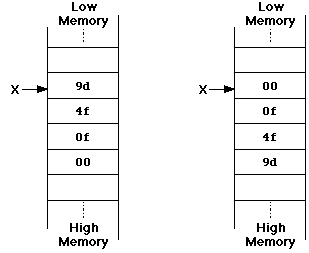
Take, for example, the integer
1003421dec
(000f4f9dhex). We assume that this
integer is stored at address X in memory. In
the Little-Endian storage, shown at left, the byte at the "address
of" the integer has value 9dhex. In
Big-Endian storage, shown at right, the byte at the "address of"
the integer is 00hex.| Lecture 24: Data Formats and Encoding -- A Philosophy Lecture | Copyright © 2005 P.Scott, La Trobe University Bendigo. |